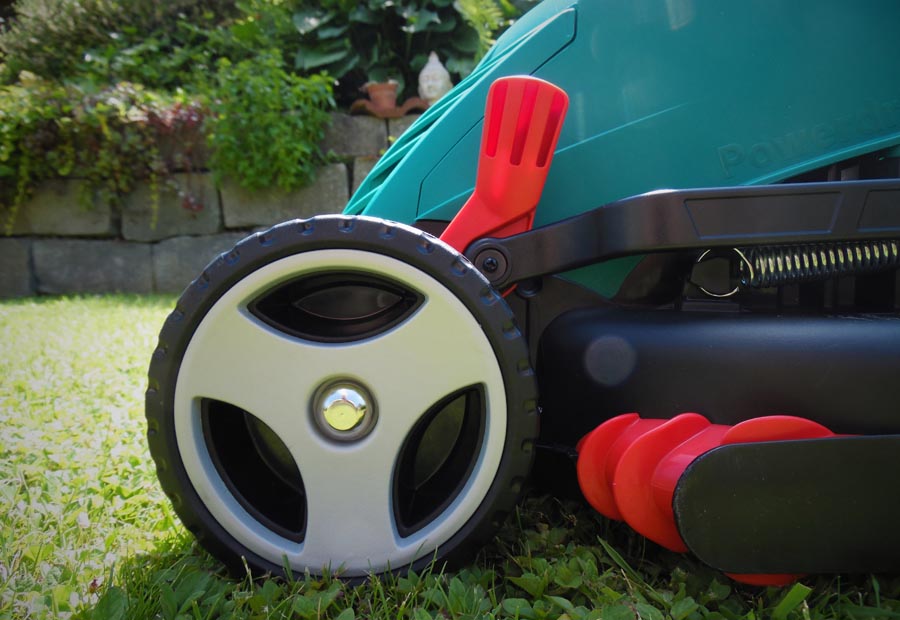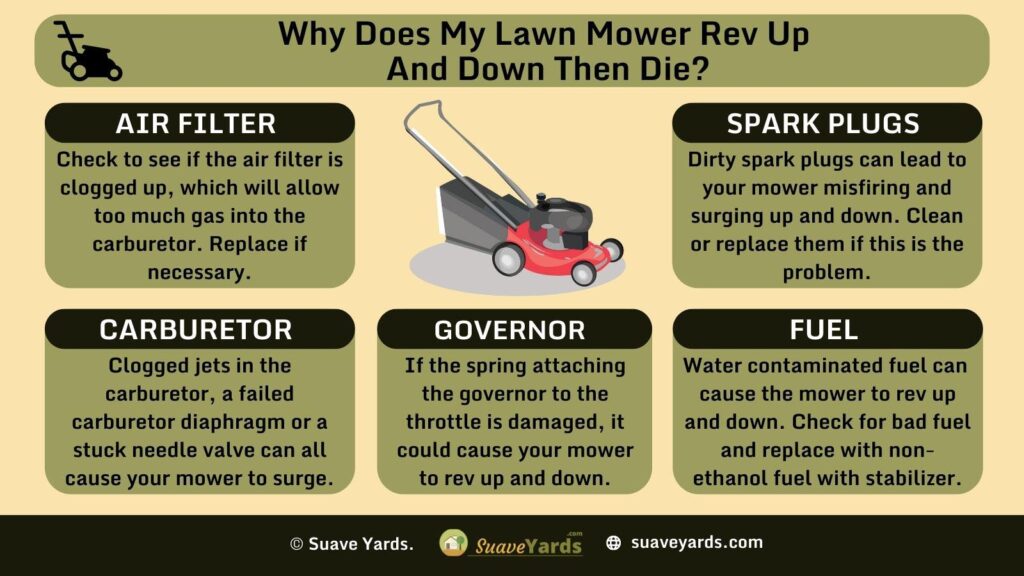
So you are here because you want to know why your lawn mower revs up and down, and then dies?
Or maybe the engine is just revving up and down without dying?
Either way, it is an annoying problem to have but the good news is you can usually fairly easily pinpoint what is causing the issue.
And normally it is pretty easy to fix as well.
So let’s take a closer look at how to remedy this problem.
Why Does My Lawn Mower Rev Up And Down Then Die?
If your mower is revving up and down and/or dying, you should check for any clogged components. Most notably this will be the air filter and carburetor, or the diaphragm in the carburetor might simply need replacing. Also, check the spring attaching the governor to the throttle, and make sure your gas isn’t water contaminated.
Just for information, you might have heard this problem called several other things. Sometimes it is referred to as a lawn mower hunting and surging, sometimes as RPM hunting, sometimes as governor hunting, and sometimes simply just surging and revving.
They all mean the same thing and can all be resolved in the same way.
ISSUE #1: Check the Air Filter
The first place to start when trying to determine why your mower engine is revving up and down is to check the air filter.
A dirty or clogged air filter can cause the fuel mixture in the mower to be too rich.
That is because if your air filter is clogged up, it means there is more gas in the carburetor than normal.
All you need to do here is replace the air filter. This is a pretty easy job and the reason why it is the first thing you should check.
ISSUE #2: Check the Carb
The root cause of any engine hunting and surging often involves the carburetor.
An air leak to the carburetor, an incorrect air-to-fuel mixture adjustment or a dirty carburetor can all be to blame.
More often than not it is the last of these that is causing the problem. Dirty, clogged jets in the carb, starts off a chain reaction.
The clogged jet means that the engine is not getting enough fuel, the RPM drops, the governor opens the throttle, air and fuel rushes in, the engine surges then drops, and the cycle is then repeated.
To fix this you simply need to clean out the clogged-up jet. Don’t do this using wire as you could damage the jet, instead buy some dedicated carb cleaner or gives it a blow with some compressed air.
RELATED ===> Buyers Guide: The Best Lawn Mowers on the Market
It could also be that the rubber diaphragm in the carb needs replacing, as this is how a lot of smaller engines regulate fuel pressure.
When these diaphragms get old they can often dry out and stop working. A new diaphragm should not cost any more than $10, make sure you have the correct model and number to order the right diaphragm as there are more than you would think!
Sometimes the needle valve on the diaphragm can get stuck too. Adding a little seafoam to the gas tank will often loosen the needle.
Some particular brands are more prone to problems with the carb than others.
If you have a carb on the tank Briggs and Stratton engine that is revving up and down, often it is because the carb diaphragm is getting old and brittle and needs replacing.
Honda builds solid motors, but their carburetors are very finely engineered and very sensitive to gas quality.
If the engine of your Honda lawn mower is revving up and down you might want to disassemble and clean the carb.
Or you could try dropping the float bowl and loosening the vertical jet from below. Then blow it with some compressed air to clean it and reattach.
There is also the option for any of these issues of simply replacing the carburetor. They are fairly inexpensive and can be replaced by a professional if necessary.
ISSUE #3: Check the Governor

Most small engines are equipped with a governor. This stops the engine from over-revving by reducing the carburetor’s throttle opening
Essentially it is there to govern the speed of the engine, and keep it running at a safe speed.
The governor is an air vane that is attached to the throttle wire by a spring, this spring brings the engine back to neutral.
As the engine runs faster, the air from the cooling fins on top of the engine pushes against the air vane. The air vane move the throttle and slows the engine down.
Then as the air decreases the spring reopens the throttle and the engine RPMs increase.
RELATED ===> How Hot Does A Lawn Mower Engine Get?
So a lawn mower engine that is continually hunting and surging, indicates there could be a problem with the governor.
And more often than not it stems from the spring that connects the governor to the throttle.
If the spring is dirty, weak or damaged in some way, or has worked itself into the wrong place the governor will not be able to regulate the speed of the engine effectively.
Check the spring to see if it is broken, and move the throttle shaft in the carb to see if it is sticking.
Replacing the spring usually solves the problem.
ISSUE #4: Check the Spark Plugs
Dirt in the spark plugs can cause them to lose contact with each other and misfire.
This could not only make the engine surge, but it could also lead to excessive wear on pistons or valves.
Take a look and replace them if necessary.
ISSUE #5: Has It Been in Storage For a Long Time? Check the Fuel…
Have you just got your mower out for the season? Is it revving up and down?
The problem could be water-contaminated fuel.
The ethanol in modern gas is notorious for attracting water. Water sinks to the bottom of the fuel tank, where it gets sucked into the carb and through the engine.
Even just a small amount of water can cause problems for a lawn mower engine.
You will need to get rid of the bad gas and possibly clean the carb too.
Using ethanol-free gas and mixing in some stabilizer should eliminate the chances of this happening again.
How to Fix a Surging Engine: An Overview
We’ve outlined above how to fix each particular problem, but as a quick overview:
- AIR FILTER: Check and replace if dirty.
- CARBURETOR: Check for clogged jets and clean if necessary. Check the carb diaphragm and replace if necessary. Try adding seaform to engine to loosen a stuck needle valve. If all else fails replace the carburetor!
- GOVERNOR: Check the governor spring and replace it if it is damaged or weakened.
- SPARK PLUGS: Check and clean or replace the spark plugs if they are dirty or worn.
- FUEL: If fuel is water contaminated, drain it out, clean the carburetor and then refill with non-ethanol fuel with some stabilizer mixed in.
RELATED ===> Why Are Lawn Mowers So Loud?
Lawn Mower Not Revving High Enough? Check These.
If your mower is actually not revving high enough as opposed to hunting and surging, then often following any of the steps outlined above will solve the problem.
A few extra points things to consider though.
First of all check the air filter. If it looks clogged take it out and try and start the engine. If the engine runs normally, then the air filter is your problem and just needs replacing.
The governor arm or spring could be in the wrong position and pulling the throttle rod down further than it should be. This makes the engine go slow.
Check the ring around the intake tube behind the carburetor. Sometimes it pops out, which allows air to leak around the tube and causes the engine to slow down.
Or often it is a faulty carburetor diaphragm here that just needs replacing.
Check the throttle shaft. There should be raised stop, just above the carb outlet, where it connects to the intake pipe.
If you rotate the throttle shaft counter-clockwise it should bump up and not be able to go any further.
If it goes past that stop, it means the shaft cannot rotate properly and open the throttle. The result? The engine runs at idle only.
Final Thoughts

Hopefully if you have turned on your mower only to find it constantly revving up and down/hunting and surging and also possibly dying, then this has helped you solve that problem.
Start off by checking the air filter, as that can often be the cause, and if it is it is one of the easiest and cheapest parts to replace.
If that doesn’t solve it, the two main parts to check are the carburetor and the governor.
Often water contaminated gas can be the culprit as well, especially if you don’t use ethanol-free gas.
Either way, I hope this hopes you solve the problem and you are out there mowing your lawn in no time!
Good luck!
